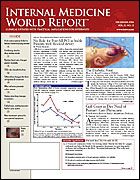Daptomycin Once Daily Effective for MRSA Bacteremia
From the Infectious Diseases Society of America
Staphylococcus
aureus
S aureus
TORONTO, Canada—Methicillin-resistant (MRSA) infections are on the rise in hospitalized patients and in the community, thus new treatments are constantly necessary. The intravenous lipopeptide antibacterial daptomycin (Cubicin), which was approved in May 2006 for the treatment of bloodstream infections, is an effective alternative to vancomycin (Vancocin), with initial treatment with low-dose gentamicin, for patients with MRSA bacteremia or right-sided endocarditis, new data presented at the Infectious Diseases Society of America annual meeting show.
S aureus
N Engl J Med
In a recently completed trial, daptomycin was also found to be an appropriate alternative to standard therapy for the treatment of bacteremia or endocarditis (. 2006; 355:653-665). This agent was previously approved for the treatment of severe skin infections.
New results from a subset analysis of patients with MRSA were presented at the meeting. In this study, patients (n = 45) were randomized to either daptomycin at a dose of 6 mg/kg daily, or vancomycin (n = 43) 1 g, every 12 hours, with initial low-dose gentamicin, for a median of 5 days.
A total of 22% of those who received daptomycin and 9% of the vancomycin-treated patients were aged ≥75 years. Additional differences included: the percentage of patients with permanent intravascular foreign material was lower in the daptomycin group (9% vs 19%), and more patients in the daptomycin group had surgery within 30 days before diagnosis with MRSA bacteremia compared with the vancomycin group (47% vs 35%).
Success was defined as clinical improvement with clearance of MRSA bacteremia among patients who completed adequate therapy, survival to 6 weeks after the end of therapy, having received no potentially effective nonstudy antibiotics, and negative blood cultures 6 weeks after the end of treatment.
Some 20 (44%) of the daptomycin-treated patients had success assessed at 6 weeks after the end of therapy compared with 14 (33%) patients treated with vancomycin and gentamicin. The difference in favor of daptomycin was maintained among patients with both complicated and uncomplicated MRSA bacteremia.
S aureus
Persisting or relapsing MRSA bacteremia was present in 27% of the patients treated with daptomycin and 21% of vancomycin-treated patients. Minimum inhibitory concentration rose to 2 μg/mL in isolates from 5 patients treated with daptomycin and in 4 patients treated with vancomycin. Treatment-limiting adverse events contributed to failure in 7% of the patients receiving daptomycin and 16% of the patients receiving vancomycin (nonsignificant differences).
“We found that daptomycin is numerically better than vancomycin at treating MRSA bacteremia….Prior treatment with vancomycin did not predispose people to failing with daptomycin. We also observed a safety advantage for daptomycin, because there was relatively little creatine phosphokinase elevation or muscle problems,” reported coinvestigator Helen Boucher, MD, director of the Infectious Diseases Fellowship Program at Tufts-New England Medical Center, Boston. “On the other hand, we observed significantly more renal failure in the patients treated with vancomycin and initial low-dose gentamicin, and this was an unexpected finding.”
Dr Boucher said bloodstream infections are increasing dramatically in the hospital and in the community.
IMWR
“We now know from our study that in a prospective randomized fashion that daptomycin once a day alone works as well as combination therapy in the treatment of these very serious infections,” Dr Boucher told . “It has been over 25 years since we have had a randomized study like this, so it is very important news.”
In a second study presented at the meeting, researchers reported that daptomycin achieved more rapid resolution of symptoms and cure, and reduced length of hospital stay and duration of treatment compared with vancomycin in the treatment of complicated skin and skin structure infections (cSSSI). This prospective, open-label study compared 47 patients (mean age, 45 years) taking daptomycin and 188 patients taking vancomycin.
Clinical cure was achieved at a mean of 4 days for patients receiving daptomycin compared with 7.5 days for patients receiving vancomycin. The median total length of hospital stay was 5 days for the daptomycin-treated patients and 14 days for the vancomycin-treated group.
